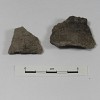
| Culture | Branch | Tradition | Ware | Type |
| Ancestral Pueblo: Southern Colorado Plateau (Anasazi) | Central Anasazi | Northern San Juan | Northern San Juan Gray Ware | Moccasin Gray (Neckbanded) |
Type Name: Moccasin Gray (Neckbanded) |
|
| Period: | 775 A.D. - 950 A.D. |
| Culture: | Ancestral Pueblo: Southern Colorado Plateau (Anasazi) |
| Branch: | Central Anasazi |
| Tradition: | Northern San Juan |
| Ware: | Northern San Juan Gray Ware |
First posted by C. Dean Wilson 2012
Moccasin Gray was defined by Abel (1955). This type is distinguished from other Northern San Juan Gray Ware types by the one or more wide coil junctions on the neck of the vessel (Breternitz and others 1974; Oppelt 1955; Rohn 1977; Wilson and Blinman 1995). Moccasin Gray is similar of Kana'a Gray as defined for the Cibola and Kayenta traditions, to Sheep Springs Gray and of Tocito Gray for the Chuska tradition, and to Rosa Neckbanded for the Upper San Juan tradition.
The coils tend to be relatively wide, and there is no exaggeration of the junctures by overlapping the coils or tooling the junctures between coils such as in Mancos Gray. Wide coils or fillets begin at the rim, and the rim fillets tend to be vertical as opposed to the everted rims on most corrugated gray ware vessels. Fillets are almost always limited to the upper neck or may extend down to the shoulder of the vessel. The difference between neckbanding on Moccasin Gray and Mancos Gray is gradational, and it is not unusual to have sherds classifiable as both types from the same vessel. Moccasin Gray vessel forms are overwhelmingly dominated by wide mouthed cooking or storage jars. Ollas are extremely rare and other forms are absent.
Examples of vessels dating prior to A.D. 820 tend to have stacked necks reminiscent of Chapin Gray cooking or storage jars rather than the more classic slightly flared necks of mid to late-ninth century vessels. Moccasin Gray is found in ceramic assemblages in the Mesa Verde region dating as early as A.D. 775, but it can be absent from assemblages dating as late as A.D. 800 (Blinman 1988). It is consistently present by about A.D. 820 and is the dominant formal gray ware type from A.D. 840 through about A.D. 870. It persists in diminishing quantities through at least A.D. 950. Although Moccasin Gray sherds are often more abundant than Chapin Gray sherds in early to mid-ninth century assemblages, more classifiable sherds are produced by neckbanded vessels than by Chapin Gray vessels, and the type frequencies should not be interpreted as representing the frequencies of vessels of the two types.
References:
Abel, Leland J.
1955 San Juan Red Ware, Mesa Verde Gray Ware, Mesa Verde White Ware and San Juan White Ware, Pottery Types of the Southwest: Wares 5A, 10A, 10B, 12A. Museum of Northern Arizona Ceramic Series 3B, Flagstaff.
Blinman, Eric
1988 The Interpretation of Ceramic Variability: A Case Study from the Dolores Anasazi. Ph.D. dissertation, Department of Anthropology, Washington State University, Pullman.
Breternitz, David A., Arthur H. Rohn, Jr., and Elizabeth A. Morris
1974 Prehistoric Ceramics of the Mesa Verde Region. Museum of Northern Arizona Ceramic Series 5, Flagstaff.
Oppelt, Norman T.
1992 Earth Water Fire: The Prehistoric Pottery of Mesa Verde. Johnson Books, Boulder.
Rohn, Arthur H.
1977 Cultural Change and Continuity on Chapin Mesa. Regents Press, Lawrence.
Wilson, C. Dean, and Eric Blinman
1995 Ceramic Types of the Mesa Verde Region. In Archaeological Pottery of Colorado: Ceramic Clues to the Prehistoric and Protohistoric Lives of the State's Native Peoples, edited by R.H. Brunswig, B. Bradley, and S.M. Chandler, pp. 33-88. Colorado Council of Archaeologists Occasional Papers 2, Denver.
Related Photos
 © New Mexico Office of Archaeological Studies, a division of the New Mexico Department of Cultural Affairs.
© New Mexico Office of Archaeological Studies, a division of the New Mexico Department of Cultural Affairs.
The Center for New Mexico Archaeology
7 Old Cochiti Road
Santa Fe, NM 87507
505-476-4404
Fax: 505-476-4448


